Fourth, Taekwondo as an Educational Method
Taekwondo trains the body, but does as much to develop the mind as well. The objective of learning Taekwondo is to foster growth in both areas in order to become a more mature human being. Taekwondo learners receive repeated etiquette lessons along with the attack and defense skills to build and strengthen their character.
The roots of Taekwondo belong to Taekkyeon, a traditional martial art form. In turn, the roots of Taekkyeon can be traced as far back as tribal times in Korea. Taekkyeon has been known under different names throughout the ages and found quick growth during the age of the three kingdoms (a period during the 4th to 7th century when the Goguryeo, Silla, and Baekje kingdoms fought with each other for dominance of the Korean peninsula). Afterwards, Taekkyeon would see more development and evolution during the Goryeo era (AD918∼ 1392), a time in which those skilled in the military arts were much respected. During that time, Taekkyeon was used as a way to determine promotions in the army. But things changed with the arrival of the Joseon era (AD1392 ~ 1910), in which the sword began to be viewed as a lowly thing. As a result, Taekkyeon slowly receded into obscurity. Currently Taekwondo, a descendent of Taekkyeon, is loved as a world class sport as a result of the painstaking effort of many individuals.
The reason why Taekwondo has been able to gain such success in modern times as a competitive sport (when compared to other Asian martial art forms) can be attributed to the fact that there has traditionally been a strong competitive aspect to Korean martial arts culture.
Taekkyeon was enjoyed in past times at many folk festivals, as a healthy competition between neighboring villages. There are records showing that men liked to place bets on the outcome of Taekkyeon matches.
The late Joseon era’s ‘Haedongjukji’ text provides the most accurate description of Takkyeon available from past records, and writes this about the martial art:
“There is something called ‘Gaksul’ (an old name for Taekkyeon) in the old ways, where two opponents face each other and places kicks in order to fell the other. There are three levels to this. The least skilled man goes for the legs, and a good man kicks the shoulders. The best man can kick as high as the head. Our ancestors used this in order to gain revenge, and even to win a woman through a bet.”
|
Taekwondo athletes can be divided into two major types. The first is the offensive athlete, who uses impressive skills and shows an aggressive approach to the match. A defensive athlete, on the other hand, defends himself calmly while looking for a clean hit in order to score points. When watching the game, explore the history of each athlete to figure out what type each one is- then use the scoring method below to predict who will win. |
 |
Scoring Method
Because Taekwondo is a highly aggressive sport, men fight in 3 minute increments, 3 times, with a 1 minute break in between. Women fight in 2 minute increments, 3 times, with 1 minute breaks. Points can be added or deducted, and scores earned during each of the three sessions are tallied up at the end to determine the winner. In the case of a tie, the winner is the one who earned the most positive points. When that is impossible as well, the winner is at the discretion of the judges, who select the athlete who has shown the best attacks during the match. |
|
| How Points are Calculated |
 |
 Earn Points (+2 Points) Earn Points (+2 Points)
Using feet: Knock an opponent off their feet with a strong kick to the face for 2 points.
Earn Points (+1 Points)
Using fists: When a clean hit is delivered to the blue or red areas of the protective gear on the body. A clean hit means the opponent is moved by the impact or there was a strong hitting sound.
Using feet: When a clean hit is delivered to the blue or red areas of the protective gear on the head and body.
Warnings (-0.5 Points)
1) Illegal contact
-Grabbing the opponent
-Wrestling the opponent
-Pushing the opponent
-Touching the opponent with one's body
2) Shows of cowardice
-Going outside the lines on purpose to evade attack
-Showing your back to the opponent while evading attack
-Falling on purpose
-Pretending to be hurt
3) Illegal strikes
-Impacting the forehead with the knees
-Kicking the groin area purposely
-Stepping on a fallen opponent's thighs, shins, knees, etc
-Hitting the face with the hand
4) Bad conduct
-When the athlete or coach argues about points given
-Bad conduct by the athlete or coach
-When the coach leaves his seat
Deductions (-1 Points)
1) Illegal contact
-Felling the opponent by grabbing with the hands
-Grabbing an opponent's leg during a kick in order to fell them
2) Shows of cowardice
-Going outside the match area to evade attack
-Purposely making it difficult to continue the match
3) Illegal strikes
-Hitting a fallen opponent
-Hitting an opponent after the referee orders to fall apart
-Hitting the back of the head or back purposely
4) Bad conduct
-Extremely bad conduct by the athlete or coach
| Taekwondo awards levels and belts according to the level of mastery demonstrated by the student. Low levels are from Level 8 to Level 1, and high levels are from the lowest 1 ‘dan’ or 1 ‘pum’ to the highest 4 ‘dan’ or 4 ’pum.’ ‘Dan’ and ‘pum’ signify the same thing, but the term ‘pum’ is used for those 15 or under while the term ‘dan’ applies to anyone 16 or older. Each level has its own ‘Pumsae,’ a predetermined set of movements that one can use to gain practice against an imaginary opponent. Different colored belts are awarded according to the level attained. |
 |
| Level | Pumsae | Belt Color |
| Low Level | No Level | Basic Position |  |
| Level 8 | Taegeuk 1-Jang |  |
| Level 7 | Taegeuk 2-Jang |
| Level 6 | Taegeuk 3-Jang |  |
| Level 5 | Taegeuk 4-Jang |
| Level 4 | Taegeuk 5-Jang |  |
| Level 3 | Taegeuk 6-Jang |
| Level 2 | Taegeuk 7-Jang |  |
| Level 1 | Taegeuk 8-Jang |
| High Level | 1 Pum, 1 Dan | Goryeo | Pum | Dan |
| 2 Pum, 2 Dan | Geumgang |  |  |
| 3 Pum, 3 Dan | Taebaek |
| 4 Pum, 4 Dan | Pyeongwon |
 |
* The belt colors outlined above are basic, but depending on the discretion of a Taekwondo master, belt colors offered at a specific place of learning can increase or decrease.
Taekwondo is Korea’s most representative martial arts and is a globally-recognized sport. Not just an important defensive art that has played a key part in Korean history, Taekwondo also improves the physical abilities and mental strength of its practitioners.
Want to learn more about this exciting skill? Highly-trained masters (many with experience in both Taekwondo and Hapkido) welcome international visitors of all ages and experience levels to join in the fun for an unforgettable Taekwondo Experience!
If your time is limited and you’re a Taekwondo beginner, you may want to try the ‘Namsangol Hanok Village Taekwondo Experience Program’ (1 hr) or the ‘1-Day Taekwondo Culture Tour’ (choose between a 90-min or a 3-hr Taekwondo class). For a deeper look into the world of Taekwondo, check out the ‘Taekwondo Training Programs,’ which can be taken anywhere from 2 to 15 days and can accommodate Taekwondo students of all levels.
For anyone unable (or not quite ready) to jump in and learn Taekwondo, there is also a Taekwondo performance titled ‘Legend of Taekwondo,’ an amusing story that sets the backdrop for a stunning display of skill by Taekwondo masters.
Taekwondo Programs for Beginners
* Namsangol Hanok Village Taekwondo Experience Program

This program is an hour-long class in which students learn the basic forms of Taekwondo, self-defense techniques, and wood-breaking. Classes are run three times a day every Wednesday, Saturday, and Sunday at the Namsangol Hanok Village. Those who would like to participate in the Taekwondo program are asked to make a reservation in advance by calling the number below or registering online. Classes may be cancelled if there are less than 5 participants for any given time slot. Customized programs with flexible dates and times can be arranged for groups of 20 or more.
ReservationsHomepage: http://www.taekwonseoul.org/2011test/eng/index.html (Korean, English, Japanese, Chinese)
E-mail: taekwondo@taekwonseoul.org
Tel: 02-3469-0134
Towards the end of each class period, students are rewarded for their hard work with a certificate of completion and a chance to take photos of themselves in their Taekwondo uniform (provided free for use during class time
* Regular Taekwondo performance: ‘Legend of Taekwondo’

‘Legend of Taekwondo’ is a Taekwondo performance combining traditional Korean dance and Taekwondo moves. The non-verbal performance depicts the fight for a beautiful and hopeful world in the face of an evil god who wants only strife.
The performance is comprised of three acts: Act 1 ‘Land of the Morning Calm,' Act 2 'Soul of Taekwondo,' and Act 3 'Legend of Taekwondo.' The free show is performed in the Cheonugak Stage area of Namsangol Hanok Village from 4pm to 5pm on Wednesdays, Saturdays, and Sundays.
TIP: Those participating in the Taekwondo experience program from 5pm-6pm, can check out this show of masterful moves for some inspiration before heading off to class.
Information on 'Legend of Taekwondo' (regular Taekwondo performance): http://www.taekwonseoul.org/2011test/performance/subscription.html (Korean, English, Japanese, Chinese)
Information on 'Legend of Taekwondo'
| Program | Location | Schedule | Details | Fees |
|---|
| Taekwondo Performance | Cheonugak Stage
Namsan
ol Hanok Vi
lage | Apr.-Dec., 2011
Wed., Sat. & Sun.
16:00-17:00 | +82-2-594-4022
(Korean, English) | Free |
Taekwondo Experi
nce Program | Namsangol Hanok Village | Apr.-Dec., 2011
Wed., Sat. & Sun.
11:00-12:00
14:00-15:00
17:00-18:00 | Basic forms, self-defense techniques, wood-breaking | 20,000 won
(1-hour class) |
* Schedule subject to change.
* Classes may be cancelled due to inclement weather.
* No classes or performances in July or August.
Last updated September, 2011

Taekwondo 1-Day Culture Tour
Taekwondo Tour
| 3-hour program | 90-minute program |
|---|
100,000 won per person
Includes: class, certificate of completion, uniform, and a souvenir
Pick-up services available
Group discount (5+ people): 90,000 won per person | 50,000 won per person
Includes: certificate of completion, and a souvenir
Pick-up & uniform rental services available
Group discount (5+ people): 40,000 won per person |
* The 90-minute program excludes take-home uniforms and the demonstration and self-defense portions of the program.
* When signing up for the Taekwondo 1-Day Culture tour, you must give your full name in English and your height. This program is designed for beginners, so if you have prior Taekwondo experience, please notify coordinators in advance so that the program can be tailored to your specific needs.
* 3-hour Program Schedule
 Putting on your uniform Putting on your uniform  Demonstration Demonstration  Meditation Meditation  Warm up exercises Warm up exercises  Basic movements Basic movements  Jabs & punches Jabs & punches  Kicks Kicks  Mitt kicking Mitt kicking  Self defense Self defense  Breaking Breaking  Sparring Sparring  Closing ceremony Closing ceremony  Group picture Group picture
* Taekwondo Training Program
- Length:
- Choose from 2 to 15 days
- Time:
- 3 hours a day
- Price:
- ~50,000 won per day (the longer the stay, the more discount rates apply)
- Note:
- Lessons take place in the morning, so that afternoons can be spent freely. The following Taekwondo classes are typically attended by those who already have experience in Taekwondo, so uniforms are not provided. Uniforms may be purchased, however, at discounted prices.
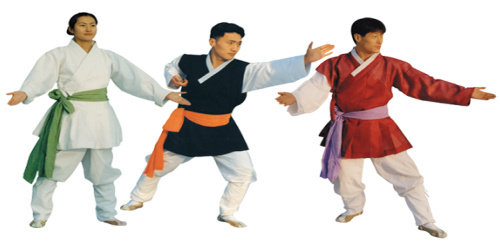 |
Taekkyeon (The art of kicking and tripping) Together with Taekwondo, Taekkyeon is a well-known traditional martial art in Korea. This method of self-defense includes numerous foot motions and fluid arm movements with the hands unclenched. Unlike other martial arts forms, there is no abrupt kicking or punching. There is more emphasis on low kicks and leg sweeps to make the opponent lose balance and knock him/her to the ground. While some people see certain similarities between Taekkyeon and the motions of Taekwondo and Chinese Kung Fu, the techniques and principles clearly differ. While Taekwondo movements are rather rigid, straight, and restrained, those of Taekkyeon are curved; and while Kung Fu movements are long and stretched, those of Taekkyeon are short and springy. Also, Taekkyeon relies on the pushing strength in the palm of the hand as compared to the use of the fist in Kung Fu. Beneath light and gentle movements reminiscent of a masked dance, lies tremendous strength which can deliver a debilitating blow or even death to an opponent.
Nowadays, Taekkyeon is widely used in gymnastics and fitness sports, especially because of the flexibility and spontaneity of the movements. Recently, it has become popular with women because it is less intense than other martial arts. |
|
 | History of Taekkyeon |
|
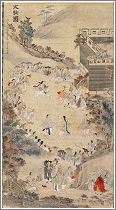
The history of Taekkyeon can be traced back to the ancient tombs of Muyongchong and Samsilchong of the Goguryeo Dynasty. Tomb wall paintings believed to portray Taekkyeon, show figures paired in a combative stance with hands reaching forward. Evidence has been found dating back to the Goguryeo era, when martial art techniques were highly advanced. At that time, a large number of military men practiced Taekkyeon. During the Joseon era, Taekkyeon matches were quite popular, even among the common people. Recently, however, most Taekkyeon masters have died or retired, and there are few left to carry on the tradition. Thus, in 1983, the government designated the martial art as an Important Intangible Cultural Property for its preservation and popularization. |
|
 | Techniques and Principles of Taekkyeon |
|
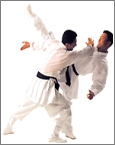 Taekkyeon relies more on defense than on offense. Fluid, spontaneous movements of the hands, feet, and body move consistently with the muscles. Another notable characteristic is its lyrical, dance-like rhythm, which characterizes it as a highly artistic martial art. A few of the major Taekkyeon techniques include the basic pose wonpum (standing with feet at shoulder width) and its variation pumbalgi, which is a stepping sequence in a triangular motion. The movement involves taking a step and shifting the weight to that step, and then to the previous step; this is done back and forth, side to side. Foot techniques include the following: front kicks with the top of the foot; spinning the body and kicking with the arch of the foot; kicking outside in; jumping and kicking; spinning the body and kicking with both hands on the floor; and slapping the opponent’s face with the sole of the foot. Some hand techniques are: pushing the opponent by the neck; jabbing the opponent with the wrist on his/her chest or neck; pulling the opponent by the leg after getting him/her down on the floor by a kick; striking the opponent's neck using the heel of the hand; and thrusting one’s fingers into the opponent’s eyes. The hwalgaejeotgi technique, which consists of waving both arms to confuse the opponent's vision or pre-empt an attack, and the yelling of ikkeu, eikkeu are also Taekkyeon techniques. Taekkyeon relies more on defense than on offense. Fluid, spontaneous movements of the hands, feet, and body move consistently with the muscles. Another notable characteristic is its lyrical, dance-like rhythm, which characterizes it as a highly artistic martial art. A few of the major Taekkyeon techniques include the basic pose wonpum (standing with feet at shoulder width) and its variation pumbalgi, which is a stepping sequence in a triangular motion. The movement involves taking a step and shifting the weight to that step, and then to the previous step; this is done back and forth, side to side. Foot techniques include the following: front kicks with the top of the foot; spinning the body and kicking with the arch of the foot; kicking outside in; jumping and kicking; spinning the body and kicking with both hands on the floor; and slapping the opponent’s face with the sole of the foot. Some hand techniques are: pushing the opponent by the neck; jabbing the opponent with the wrist on his/her chest or neck; pulling the opponent by the leg after getting him/her down on the floor by a kick; striking the opponent's neck using the heel of the hand; and thrusting one’s fingers into the opponent’s eyes. The hwalgaejeotgi technique, which consists of waving both arms to confuse the opponent's vision or pre-empt an attack, and the yelling of ikkeu, eikkeu are also Taekkyeon techniques. |
|
 | Taekkyeon Competition Rules |
|
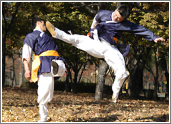 Following amendments in 1991, 1997, and 1998, Taekkyeon match regulations were settled. After paying their respects in the center of the competition area, both contestants must maintain one of his/her feet forward within attacking distance of the opponent. A contestant wins the match if any part of the opponent's body (from the knee up) touches the floor as a result of a legal attack; if he/she kicks the opponent in the face; and if, as a result of his/her kick (both legs must be in the air and higher than knee-length), the opponent loses balance or retreats by more than two steps. Following amendments in 1991, 1997, and 1998, Taekkyeon match regulations were settled. After paying their respects in the center of the competition area, both contestants must maintain one of his/her feet forward within attacking distance of the opponent. A contestant wins the match if any part of the opponent's body (from the knee up) touches the floor as a result of a legal attack; if he/she kicks the opponent in the face; and if, as a result of his/her kick (both legs must be in the air and higher than knee-length), the opponent loses balance or retreats by more than two steps.
- Competition area: The mat-covered area measures 8 x 8 meters. A circle 2.5m
in diameter demarcates the center.
- Composition of refereeing officials: 1 center referee, 2 corner judges, 1 jury,
1 timekeeper.
- Competition uniform: Contestants must wear white summer uniform pants,
cotton-padded socks, and one contestant a blue and the other a white upper garment.
- Competition classification: There are individual, team, adult, student, and children (children less than 10 years of age) competitions. The competitions are divided by gender, and sometimes by weight divisions.
- Duration of contest: For individual competitions, there are 3 rounds of 3 minutes each,
and 1 minute of rest between rounds. For team competitions, there is 1 round of 3 minutes. There is no time limit in competitions like Cheonha Myeongin (World Master Competition).
- Methods of competition: Tournament or league system, combined tournament and
league system, or round-robin system
|
|
 |
|
|


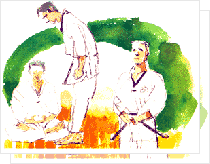


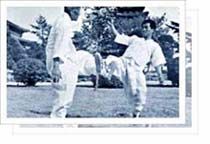
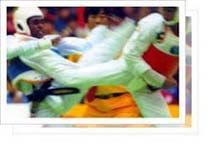
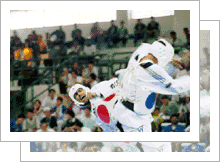












 Putting on your uniform
Putting on your uniform  Demonstration
Demonstration  Meditation
Meditation  Warm up exercises
Warm up exercises  Basic movements
Basic movements  Jabs & punches
Jabs & punches  Kicks
Kicks  Mitt kicking
Mitt kicking  Self defense
Self defense  Breaking
Breaking  Sparring
Sparring  Closing ceremony
Closing ceremony 


 Taekkyeon relies more on defense than on offense. Fluid, spontaneous movements of the hands, feet, and body move consistently with the muscles. Another notable characteristic is its lyrical, dance-like rhythm, which characterizes it as a highly artistic martial art. A few of the major Taekkyeon techniques include the basic pose wonpum (standing with feet at shoulder width) and its variation pumbalgi, which is a stepping sequence in a triangular motion. The movement involves taking a step and shifting the weight to that step, and then to the previous step; this is done back and forth, side to side. Foot techniques include the following: front kicks with the top of the foot; spinning the body and kicking with the arch of the foot; kicking outside in; jumping and kicking; spinning the body and kicking with both hands on the floor; and slapping the opponent’s face with the sole of the foot. Some hand techniques are: pushing the opponent by the neck; jabbing the opponent with the wrist on his/her chest or neck; pulling the opponent by the leg after getting him/her down on the floor by a kick; striking the opponent's neck using the heel of the hand; and thrusting one’s fingers into the opponent’s eyes. The hwalgaejeotgi technique, which consists of waving both arms to confuse the opponent's vision or pre-empt an attack, and the yelling of ikkeu, eikkeu are also Taekkyeon techniques.
Taekkyeon relies more on defense than on offense. Fluid, spontaneous movements of the hands, feet, and body move consistently with the muscles. Another notable characteristic is its lyrical, dance-like rhythm, which characterizes it as a highly artistic martial art. A few of the major Taekkyeon techniques include the basic pose wonpum (standing with feet at shoulder width) and its variation pumbalgi, which is a stepping sequence in a triangular motion. The movement involves taking a step and shifting the weight to that step, and then to the previous step; this is done back and forth, side to side. Foot techniques include the following: front kicks with the top of the foot; spinning the body and kicking with the arch of the foot; kicking outside in; jumping and kicking; spinning the body and kicking with both hands on the floor; and slapping the opponent’s face with the sole of the foot. Some hand techniques are: pushing the opponent by the neck; jabbing the opponent with the wrist on his/her chest or neck; pulling the opponent by the leg after getting him/her down on the floor by a kick; striking the opponent's neck using the heel of the hand; and thrusting one’s fingers into the opponent’s eyes. The hwalgaejeotgi technique, which consists of waving both arms to confuse the opponent's vision or pre-empt an attack, and the yelling of ikkeu, eikkeu are also Taekkyeon techniques.  Following amendments in 1991, 1997, and 1998, Taekkyeon match regulations were settled. After paying their respects in the center of the competition area, both contestants must maintain one of his/her feet forward within attacking distance of the opponent. A contestant wins the match if any part of the opponent's body (from the knee up) touches the floor as a result of a legal attack; if he/she kicks the opponent in the face; and if, as a result of his/her kick (both legs must be in the air and higher than knee-length), the opponent loses balance or retreats by more than two steps.
Following amendments in 1991, 1997, and 1998, Taekkyeon match regulations were settled. After paying their respects in the center of the competition area, both contestants must maintain one of his/her feet forward within attacking distance of the opponent. A contestant wins the match if any part of the opponent's body (from the knee up) touches the floor as a result of a legal attack; if he/she kicks the opponent in the face; and if, as a result of his/her kick (both legs must be in the air and higher than knee-length), the opponent loses balance or retreats by more than two steps.
댓글 없음:
댓글 쓰기